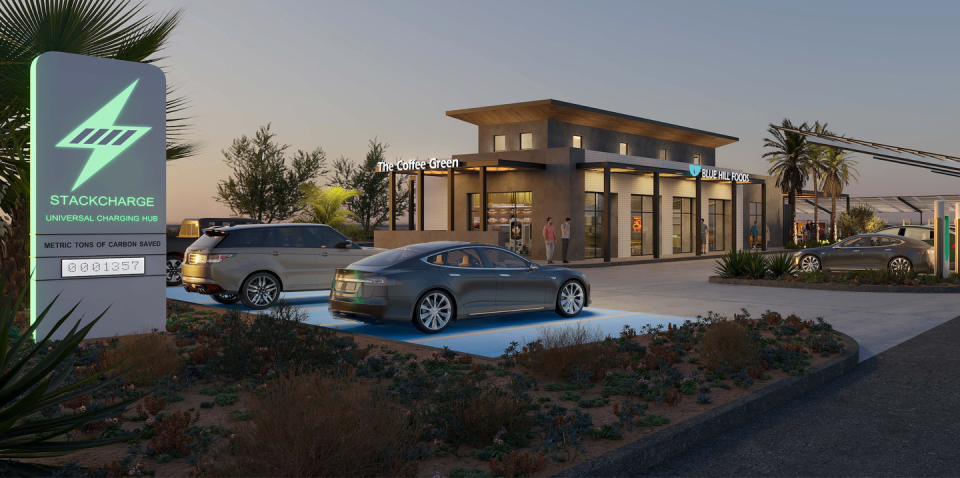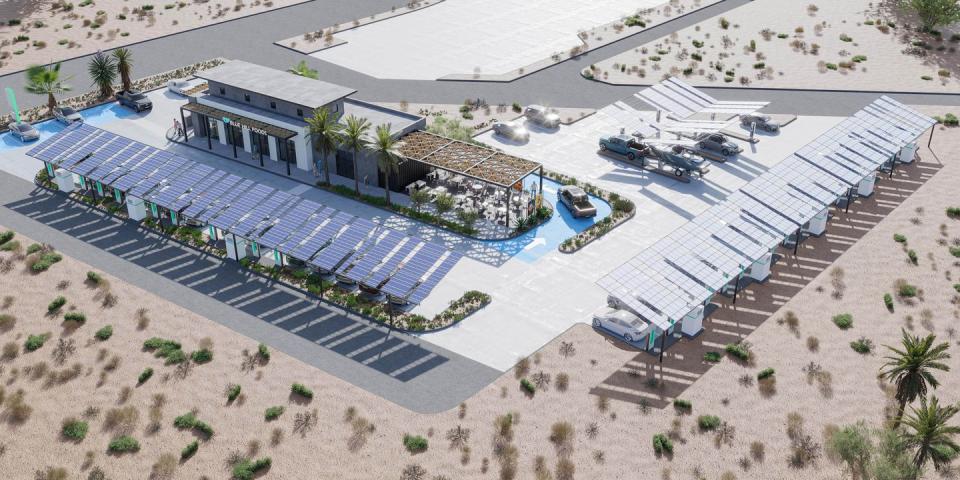Charging Lounges Help Make Plugging In a More Palatable Experience

Besides driving range, a lack of public EV charging infrastructure is cited as a significant reason buyers don’t consider purchasing an electric vehicle.
Two companies, Electrify America and Stack Charge, are starting to roll out concepts of charging stations that offer more amenities and a place to wait while plugging in on the road.
We’ve already seen a similar model deployed in Europe, with Audi playing a prominent role in building reservation-based charging lounges for its customers.
Few would claim that electric-vehicle charging has reached its full maturity, and concern about finding a place to plug in is still a deterrent to increasing the EV’s market share. Deloitte’s 2022 Global Automotive Consumer Study revealed reasons for not considering a battery-electric, and prominently cited by US car buyers were “driving range” (20%, the largest concern in the survey) and “lack of public electric vehicle charging infrastructure” (14%).
Electrify America (EA) is trying to change the public charging picture. It has 800 stations and 3500 individual chargers in the US, and provided 1.45 million charging sessions in 2021. With origins in the “dieselgate” settlement, this Volkswagen division says it will have 1800 stations and 10,000 individual chargers by 2026.
Part of the current problem is that consumers regard the charging we do have as inconvenient and sometimes poorly located, as well as suffering from technical problems and a lack of nearby amenities. In March, EA released an expansive design vision for future charging stations that should address some of the most frequently heard criticisms. The vision will become reality this year and in 2023 at locations in Santa Barbara, San Francisco, San Diego, and Beverly Hills, California; and in both Manhattan and Brooklyn in New York.

Anthony Lambkin, senior director of operations at EA, told Autoweek the company already has additional amenities such as solar awnings at existing locations, including in the charging hub of Baker, California. The Baker location is off Interstate 15—a well-traveled road that connects Los Angeles and Las Vegas. A Denver location is working on a dog park. The San Francisco location, opening later this year, will be the first station of the future, complete with a lounge.
New York’s two installations are likely to be relatively small, given real-estate costs. “Manhattan is a black hole for charging currently, but there’s a massive need,” Lambkin said. “Our fast-charging site will be in midtown.”
As EV sales take off, public charging is ready for its makeover. “This is a chance to reinvent the charging experience,” Lambkin said. “Gas stations are set up for a quick in-and-out, but we have longer dwell times—though they are getting shorter—for EV charging. Even at 10 or 20 minutes of waiting we need a new type of retail experience, leapfrogging what you’d expect to see at a gas station.”
Features of the new stations in addition to solar include waiting areas and lounges, event spaces, security lighting, valet charging and curbside delivery options, and as many as 20 redesigned DC fast chargers with up to 350-kilowatt capacity. Lambkin said food and beverage options with prospective partners are under consideration. The company hopes to have five to 10 of the new stations open in the next couple of years, he said. Beyond the US, Canada is also slated to get future stations.

Startup The Stack Charge is also focusing on California for its own vision of an expanded EV charging station with amenities. The first location, with 40 fast chargers, is on 1.29 acres, also in Baker. The opening is planned for the end of 2022 or early 2023.
Co-founder and serial entrepreneur Lawrence Fung told Autoweek, “We’re trying to improve the customer experience. People find the current charging network to be extremely inconvenient. It’s an amenity that primarily serves what’s already there, like a mall. We plan to have elevated quick-service retail, including restaurants that might serve healthier food. We are trying to avoid the usual rest-stop suspects. If we are going to offer burgers, they have to be something different. We think that’s in line with the demographic of EV owners.”
Fung’s partner, real-estate developer Lester Ciudad Real, said the station will be on a “very utilized corridor, which doesn’t have enough charging stations now. We anticipate demand to skyrocket as EVs continue to dominate the market.” In addition to the chargers and healthy fast food, the 2500-square-foot Baker location will have an outdoor plaza, Wi-Fi and 24/7 restrooms.
Real said Stack Charge plans to expand in Southern California, then into the northern part of the state. “We’re also very bullish on Las Vegas,” he said. “We are looking to acquire sites that have strong real-estate fundamentals and benefit from high-transit traffic.” Other locations under consideration include Oregon, Washington, Colorado, and Texas. The plan is to have 10 locations up in 18 months.
Stack Charge will not, at least initially, build its own chargers, but will “white label” existing units, Fung said, adding that electricity prices will be competitive. “We’re not looking to gouge people on charging.”


 Yahoo Autos
Yahoo Autos 